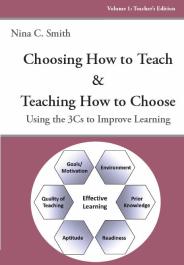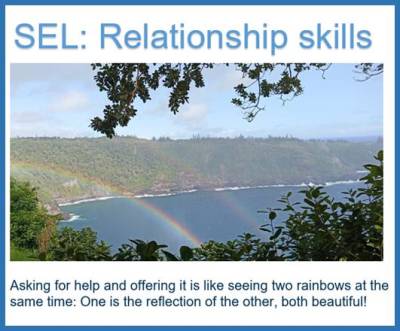How do YOU want to teach?
Teaching style is very individual choice, based on our dispositions and beliefs about knowledge and learning. Curricula, Common Core and external measurements provide a framework of WHAT needs to be taught, but you still get to decide HOW to do it!
We all as educators are facing the same question every day we start working: how do I want to teach today? Am I going to focus on delivering plain information, or will I focus more on supporting students’ learning process?
The beautiful – and obvious – answer to this question is: YOU get to choose how you teach. Regardless of the curriculum you are using, and regardless of the instructional strategies in your institution, you actually DO get to choose to engage in learner-centered instruction. Let me explain.
Teaching is only small part of the learning-teaching process that happens in classrooms (online of in person) around the world. We educators plan for the learning experience and create the learning environment for our students. But we cannot do the learning FOR them. Students must engage in building their own knowledge and understanding, they MUST engage in their own learning process. Therefore, a big part of teaching is actually engaging in the interpersonal relations and supporting students’ individual learning process, trying to make their learning experience as learner-centered as possible!
Choosing How to Teach focuses on the 3Cs approach, which helps educators to plan learner-centered instruction to support the learning process – while still following the given curriculum.
The old saying about leading the horse to the water but not being able to force it to drink is very descriptive for the differences between teaching and learning, and often also quoted as such. We attempt to measure the ways of presenting information for students to learn, and seem to think the score makes one teacher more effective than another -but I am not convinced that it makes such a big difference how we take the horse to the water: it will drink when it is thirsty. Fortunately students are born curious and ready to learn. The only thing we need to do is find a way to cooperate with that curiosity and help students preserve their interest in learning and their sense of wonder – because that is where all true learning starts: wondering if, how, when, why… here is a TIP for mentoring students with Trauma Informed Practices (TIP).
This is also where SEL (social-emotional learning) comes into the picture (please visit CASEL site to learn more if this is new information to you!). By supporting our students’ SEL competencies we are equipping them to become self-directed and self-regulated learneres. And that’s exactly what we want: for our students to become lifel-long learners!
Choosing How to Teach website has free courses about learning and teaching!
Here is a PDF about Ninas Notes for Early Learning
Choosing How to Teach & Teaching How to Choose: Using the 3Cs to Improve Learning is Nina’s Book/eBook asking every teacher the most important question:
This book about choices teachers have – and must have – was born from my experiences of exporting my Finnish teaching degree to a new continent. I often get questions about what is different, but my favourite answer is to highlight what is similar: teachers’ deep dedication to help students to learn.

This book features the themes from this blog and helps you to ignite your students’ intrinsic learning motivation! Enjoyment in learning is better for students than just going through the motions! Emphasizing learning process supports deeper learning. Choosing How to Teach also offers courses for professional development.
Find the book on: Amazon or Powells , or take a look on Barnes and Noble. If you reside in the Europe, then Waterstones or AmazonUK might be a better choice. Kirja on tilattavissa Suomessa ja muissa Pohjoismaissa myos Adlibriksen kautta: Adlibris
Also available as Kindle version!
The next transformation in education is already on our doorstep. There is evidence of small changes in classrooms all over the world slowly rising to represent a paradigm shift in mainstream education. This is a shift from the old theories of education – rote memorization led by an authoritarian force – to a more collaborative environment where students are empowered to become lifelong learners and encouraged to be responsible for their own learning.
There is also a growing global understanding about the importance of this empowerment:
“For those who have successful experience of education, and who see themselves as capable learners, continuing learning is an enriching experience, which increases their sense of control over their own lives.” (OECD, 1997b, p.1)
What’s the best way of changing the way we approach teaching and learning for students? Being informed and empowered by the very people who work hands-on with it in their profession – teachers. Empowerment is an underlying principle in all real learning. For a teacher, it means helping students either master the subject so well that they will not need a teacher anymore, or to become self-sufficient so that they know where to find more information if they need to learn more. For a student, it means being accountable for your own learning, being encouraged to learn more, and also taking responsibility for your choices.
Student empowerment is, in principle, actually the same as in raising children: teaching students how to connect pieces of information to give that information context, and helping them to make good choices so that they can successfully meet challenges in life.



I really like how you present the importance of collaboration in learning. I taught comparative religion in secular colleges for several years. I found that through group discussion the class could progress through difficult religious texts that individual students could not have achieved. Keep up the good work!
Thank you for your kind words! The ultimate truth is that we add up to each other’s knowledge and wisdom – if we are willing to listen. During my master’s studies I was fortunate to have professors who acknowledged the joint knowledge of our group and were skillfully facilitating our learning. I am in great debt to all the excellent teachers I have had.
Thank you so much for sharing this. I agree, teaching students is one of the most difficult tasks because as teachers, they have to be authoritative yet approachable models.
Of course! Thank you!
And just to be sure to be on the same page, here is more information about authoritaTIVE vs. authoritaRIAN models.
The first one is supportive, focusing on discipline and guidance; the second one is coercive, focusing on control and punishments. These same rules apply with parenting: https://www.psychologytoday.com/us/blog/thinking-about-kids/201409/authoritative-versus-authoritarian-parenting-style
🙂
Nina